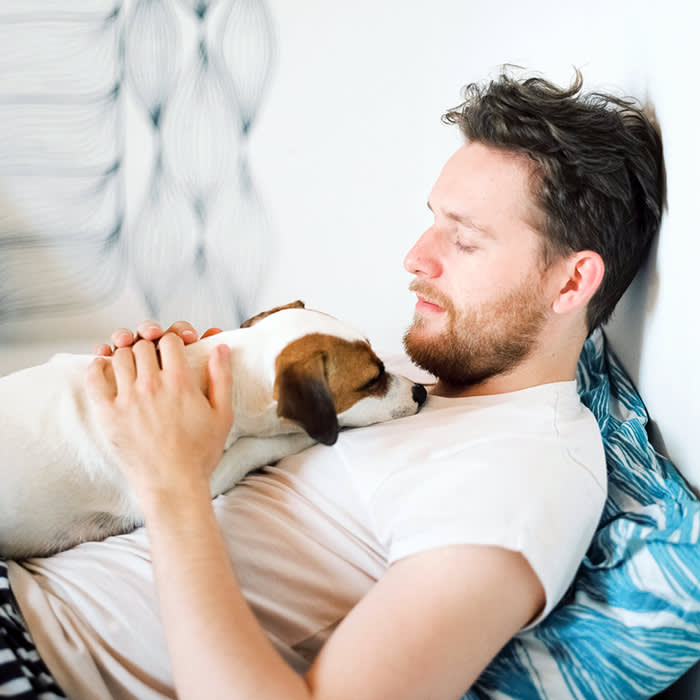Pets Are the Best Medicine for PTSD—Here’s Why
Trauma can take many forms. Along with traditional therapy, animals are a great help.

Share Article
In February of 1944, an American soldier fighting in New Guinea stumbled upon a four-pound Yorkshire Terrieropens in a new tab in an abandoned foxhole deep in the jungle. He brought the dog back to his basecamp, where she was named Smoky and acquired by Corporal William A. Wynne, who made a bed for her out of a green felt card table cover and fed her with his own C-rations and the occasional can of Spam.
Over the next two years, Smoky accompanied Wynne and his comrades on 12 combat missions and survived 150 air raids and a typhoon at Okinawa. She even saved Wynne’s life one night when she guided him to duck just before eight of his fellow soldiers were gunned down around him.

Get (totally free) deals for food, treats, accessories, tech, and way more pet parenting must-haves.
opens in a new tabSmoky’s greatest achievement, though, was perhaps as the first recorded therapy dog. While Wynne was in the hospital, in 1944, Smoky slept in his bed at night and accompanied nurses on their rounds during the day. Because they spent time with Smoky in the hospital and on the battlefield, soldiers were able to find relief from the stresses of war and a reason to be glad, even in the midst of so much horror.
Smoky became a celebrity and in the decades since, the use of dogs and other animals to help relieve trauma has only increased. But how exactly do animals help people process their trauma?
A true comfort in the storm
In her paper “Transforming Trauma: Resilience and Healing Through Our Connections With Animals,”opens in a new tab Marguerite O’Haire, associate professor of human-animal interaction in the Center for the Human-Animal Bond in the College of Veterinary Medicine at Purdue University, explores the ways animals are utilized in the treatment of trauma.
For people who have experienced trauma, animals can serve as a source of nonjudgmental support and stress-reducing companionship, provide positive outlets for joy and laughter, and be a safe haven for physical touch and emotional vulnerability.
O’Haire writes that for people trying to heal, “the significance of an animal companion in providing a sound sense of safety and wellbeing (in times of uncertainty and otherwise), an increased capacity for self-regulation, and the impetus for functional reengagement with the social environment cannot be underestimated.”
In her paper, O’Haire focuses on what she calls the three core categories of trauma: crisis response, child and family violence, and PTS. Crisis response is how one reacts in the wake of a crisis, be it a natural disaster,opens in a new tab like a hurricane, or manmade disaster, like a terrorist attack. During this delicate and difficult time, animal intervention, especially with dogs, can be tremendously helpful.
O’Haire says that working with a therapy dog can “build a bridge” between the traumatized person and crisis team member or mental health professional. The dog can also “act as a safe and calming presence” and a “transitional object to encourage present-minded thoughts and provide those in crisis with a reality-orienting focus.”
Animal therapy in abuse situations
While a crisis response tends to be temporary, child and family violence and PTS often result in ongoing, sometimes lifelong issues. In the case of child and family violence,opens in a new tab pets are sometimes a victim’s only source of love and affection.
Animal interventions can be tremendously helpful in the aftermath of this kind of abuse. “Physical contact involved in stroking the animal may release tension and assist those with trauma to achieve physiological self-regulation,” O’Haire adds. “For children in particular, the animal may play a critical role in reducing fear and distress during otherwise unpleasant and challenging interactions with adults, such as reliving traumatic events for the purposes of reporting [a crime] or testifying [in court].”
Dogs are so effective in cases like this that in 2015, black Labradors Dozer and Lupeopens in a new tab joined former California District Attorney Michael Ramos’s team as part of the San Bernardino County Special Victims K-9 Unit. The dogs worked inside the courtroom, supporting children and families while they provided testimony about the physical and sexual violence of which they had been victims.
When it comes to treating PTS, “the presence of an animal often offers a source of safety and support,” O’Haire writes. “Animals can also reduce lonelinessopens in a new tab and create connections among friends and family members through positive interactions, which may be especially important for individuals with PTS who are often socially isolated. In a more formal capacity, animals can be involved in [animal-assisted interventions] or trained as service animals to assist with individualized needs, and to address specific, daily challenges caused by PTS.”
Animals can also provide what is called a “biofeedback function.” opens in a new tabService dogs, for example, can be trained to recognize when a person is experiencing a heightened state of stress and will nudge or lick the individual until they shift their focus to the dog, at which point they can start relaxing and utilizing mindfulness techniques to pull out of their panic and refocus on the present.
As far as helping with the processing of everyday stressors, there is probably not a pet parent alive who does not find the company of their pet soothing in one way or another. And you certainly don’t have to be suffering from unresolved trauma to find comfort and joy in the companionship of a pet.
But just because an animal-assisted intervention works for a traumatized person, doesn’t mean it will work for a non-traumatized person. For instance, a soldier experiencing PTSD might sleep better and more deeply with their dog in the bed beside them. According to Dr. Brian Chin’s paper “Co-Sleeping with Pets, Stress, and Sleep in a Nationally-Representative Sample of the United States,” opens in a new tab people not suffering from PTSD will generally experience worse sleepopens in a new tab with their dog in the same bed or even just the same room.
The important thing, whether you are experiencing trauma related-difficulties or suffering from unusual or unmanageable stress, is to seek professional help. As incredible as they are, animal-assisted interventions “should not be perceived as a stand-alone or replacement treatment,” O’Haire writes. Animal therapy, combined with the expertise of a trained (human) therapist, could be the key to gaining the peace you need and deserve around this.
References:

Charles Manning
Charles Manning is an actor, writer, and fashion/media consultant living in New York City with his two cats, Pumpkin and Bear. Follow him on Instagram @charlesemanningopens in a new tab.
Related articles
![Woman petting her small service dog.]() opens in a new tab
opens in a new tabWhat People Can and Can’t Ask You About Your Service Dog
The questions will come, so you should be prepared with answers.
![Happy couple outside with their dog.]() opens in a new tab
opens in a new tabSpending Time With Dogs Can Make You Better in Social Situations, Study Says
Especially if you pet them.
![Man hugging his fluffy white dog happily]() opens in a new tab
opens in a new tabChemistry Between People and Dogs Is Real (It’s Science)
How the “love hormone” oxytocin connects us with our pups.
![A service dog for PTSD walking outside looking up at the camera]() opens in a new tab
opens in a new tabHow Service Dogs Can Ease Veterans’ PTSD
According to a study, trained service dogs can interrupt panic attacks, wake veterans from nightmares, and more.
![two girls bonding over a cute fluffy dog]() opens in a new tab
opens in a new tabHow 5 Pet Parents’ Lives Had a Glow-Up After They Got Their Pets
Turns out finding community isn’t so hard when you’ve got a cute pal to help get you out of the house.
![A woman holding a dog in her arms while looking at a scenic view of the sea.]() opens in a new tab
opens in a new tab5 Science-Backed Ways to De-Stress Outdoors (Your Pet Is Invited)
The author of Return to Nature on the mental health benefits of getting out into various natural landscapes with your pup.








